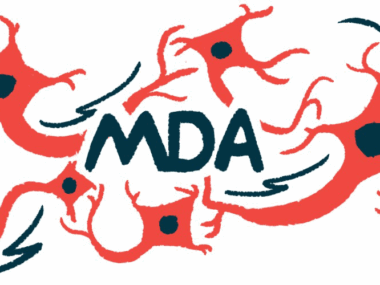Newborns given Evrysdi reaching key milestones after 2 years
Babies also able to feed orally, don’t need permanent breathing assistance
Written by |

Newborns diagnosed with spinal muscular atrophy (SMA) who were treated with Evrysdi (risdiplam) before the onset of symptoms are continuing to reach developmental milestones such as sitting, standing, and walking independently, with many achieving them in a time frame expected of typical child development.
That’s according to two-year data from the Phase 2 RAINBOWFISH trial (NCT03779334), which also showed the babies are able to swallow and feed orally, don’t need permanent breathing assistance, and have normal cognitive development.
The findings were presented by developer Genentech at the World Muscle Society Congress, in Prague. Genentech leads Evrysdi’s development in collaboration with the SMA Foundation and PTC Therapeutics.
“These [two]-year findings confirm the potential of early intervention with Evrysdi to meaningfully improve the lives of children with SMA” Levi Garrway, MD, PhD, Genentech’s chief medical officer and head of global product development, said in a company press release. “Working in tandem with newborn screening programs, Evrysdi is the only noninvasive SMA treatment that can be administered during a child’s first hours of life.”
In SMA, the nerve cells responsible for muscle control, called motor neurons, progressively degenerate as a consequence of mutations in the SMN1 gene. This leads to a lack of SMN, a protein important for muscle health. The disease-driving process starts even before there are noticeable symptoms, so it’s critical to diagnose and treat the neuromuscular disease as soon as possible.
“In children with SMA, motor neuron degeneration starts before the onset of symptoms, so time is of the essence if we hope to preserve muscle function,” said Laurent Servais, MD, PhD, professor at the MDUK Oxford Neuromuscular Center.
Results of RAINBOWFISH study
Evrysdi, a daily liquid treatment taken orally or via feeding tube, works to increase SMN by boosting the activity of the so-called “backup” SMN-producing gene, SMN2. It was initially approved in the U.S. and other countries for SMA patients 2 months and older, but data from RAINBOWFISH backed label expansions in the U.S., European Union, and Japan to include presymptomatic babies under 2 months old, making it available to SMA patients of all ages in those regions.
RAINBOWFISH enrolled 26 newborns up to 6 weeks old who’d been genetically diagnosed with SMA, but were still presymptomatic and who had two or more copies of SMN2. In general, fewer SMN2 copies is associated with more severe disease. Twenty-three babies were treated with Evrysdi before 6 weeks of age, starting at a median age of 25 days.
Trial data presented at last year’s World Muscle Society Congress showed most treated babies were reaching important motor milestones after a year of treatment, and all could swallow and feed orally. No babies required permanent breathing support and the infants had cognitive skills typical of normal development, in general.
Per the newly reported two-year findings, all of the 18 treated children with three or more SMN2 gene copies achieved motor milestones, including standing and walking. Most met the milestones in a time frame expected of typical child development.
Among the five children with two SMN2 copies, all could sit, and 60% could stand and walk independently after two years. Moreover, all the treated babies were able to swallow and feed orally after two years, and none required permanent ventilation. In the absence of treatment, babies with SMA type 1 wouldn’t be expected to reach these milestones or live past age 2, according to Genentech.
The RAINBOWFISH study was the first SMA clinical trial to assess cognition as an exploratory endpoint using a standardized scale. The results showed that, after two years of treatment, the infants exhibited cognitive skills typical of children without SMA.
“It’s heartening to see that through early intervention with Evrysdi these children have achieved important milestones like sitting, standing, and walking that would typically be unattainable without treatment,” Servais said.
The side effect profile of Evrysdi was generally similar to previous clinical trials, with the most common ones being teething, inflammation of the gastrointestinal tract (gastroenteritis), diarrhea, dry and itchy skin (eczema), and fever. Most of the side effects are more reflective of age than underlying disease, and most weren’t considered treatment-related and resolved over time, according to Genentech.







